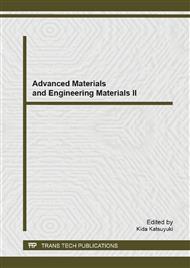[1]
Didier Clouteau, and Denis Aubry. Modifications of the ground motion in dense urban areas. Journal of Computational Acoustics, Vol. 9, No. 4(2001) 1659-1675.
DOI: 10.1142/s0218396x01001509
Google Scholar
[2]
Chrysoula Tsogka, and Armand Wirgin. Simulation of seismic response in an idealized city. Soil Dynamics and Earthquake Engineering 23(2003)391-402.
DOI: 10.1016/s0267-7261(03)00017-4
Google Scholar
[3]
Marc Kham, Jean-Francois Semblat, Pierre-Yves Bard, and Patrick Dangla. Seismic site-city ineraction: main governing phenomena through simplified numerical models. Bulletin of the Seismological Society of America, Vol 96, No. 5, pp.1934-1951, October (2006).
DOI: 10.1785/0120050143
Google Scholar
[4]
Jacobo Bielak, Kostas Loukakis, Yoshiaki Hisada, and Chiaki Yoshimura. Domain reduction method for three-dimensional earthquake modeling in localized regions, partⅠ: theory. Bulletin of the Seismological Society of America, Vol 93, No. 2, pp.817-824, April (2003).
DOI: 10.1785/0120010251
Google Scholar
[5]
Lysmey J, and Kulemeyer R.L. Finite Dynamic Model for Infinite Media. J. Eng. Mech. Div., ASCE, Vol. 95, 1969, 759~877.
Google Scholar
[6]
Clayton R., and Engquist B. Absorbing boundary conditions for acoustic and elastic wave equations. Bulletin of the Seismological Society of America, Vol. 67, 1977, 1529-1540.
DOI: 10.1785/bssa0670061529
Google Scholar
[7]
Smith W.D. A nonerflecting plane boundary for wave propagation problems. J. Computational Physics, Vol. 15, 1974, 492-503.
DOI: 10.1016/0021-9991(74)90075-8
Google Scholar
[8]
Liao Zhenpeng, Zhou Zhenghua, and Zhang Yanhong. Stable implementation of transmitting boundary in numerical simulation of wave motion. Chinese Journal of Geophysics, 2002, Vol. 45, No. 4: 533-545.
DOI: 10.1002/cjg2.269
Google Scholar
[9]
Ding Haiping, Liao Zhenpeng, and Zhou Zhenghua. Reformation of program for soil-structure intsraction. Earthquake Engineering and Engineering Vibration, Vol. 19, No. 2, 51-55, June, (1999).
Google Scholar
[10]
Liu jing bo, Wang Zhenyu, Du Xiuli, and Du Yixin. Three-dimensional visco-elastic artificial boundaries in time domain for wave motion problems. Engineering Mechanics, Vol. 22, No. 6, 46-51, December, (2005).
Google Scholar
[11]
Chiaki Yoshimura, Jacobo Bielak, Yoshiaki Hisada, and Antonio Fernandez. Domain reduction method for three-dimensional earthquake modeling in localized regions, partⅡ: verification and applications. Bulletin of the Seismological Society of America, Vol 93, No. 2, pp.825-840, April (2003).
DOI: 10.1785/0120010252
Google Scholar
[12]
E. Faccioli, M. Vanini, R. Paolucci, and M. Stupazzini. Comment and reply, comment on Domain reduction method for three-dimensional earthquake modeling in localized regions, partⅠ: theory" by Jacobo Bielak, Kostas Loukakis, Yoshiaki Hisada, and Chiaki Yoshimura and "Domain reduction method for three-dimensional earthquake modeling in localized regions, partⅡ: verification and applications" by Chiaki Yoshimura, Jacobo Bielak, Yoshiaki Hisada, and Antonio Fernandez, Bulletin of the Seismological Society of America, Vol 95, No. 2, pp.763-769, April (2005).
DOI: 10.1785/0120040106
Google Scholar
[13]
Jacobo Bielak, Reply to "Comment and reply, comment on "Domain reduction method for three-dimensional earthquake modeling in localized regions, partⅠ: theory" by Jacobo Bielak, Kostas Loukakis, Yoshiaki Hisada, and Chiaki Yoshimura and "Domain reduction method for three-dimensional earthquake modeling in localized regions, partⅡ: verification and applications" by Chiaki Yoshimura, Jacobo Bielak, Yoshiaki Hisada, and Antonio Fernandez, ", Bulletin of the Seismological Society of America, Vol 95, No. 2, pp.770-773, April (2005).
DOI: 10.1785/0120040106
Google Scholar
[14]
Christopher Bode, Reinhold Hirschauer, and Stavros A. Savidis. Soil-structure interaction in the time domain using halfspace Green's functions. Soil Dynamics and Earthquake Engineering 22(2002)283-295.
DOI: 10.1016/s0267-7261(02)00020-9
Google Scholar
[15]
Jean-Francois Semblat, Ali Gandomzadeh, and Luca Lenti. A simple numerical absorbing layer method in elastodynamics. C. R. Mecanique 338(2010)24-32.
DOI: 10.1016/j.crme.2009.12.004
Google Scholar
[16]
L. A. Padron, J.J. Aznarez, and O, Maeso. Dynamic structure–soil–structure interaction between nearby piled.
Google Scholar
[17]
buildings underseismicexcitationbyBEM–FEMmodel. Soil Dynamics and Earthquake Enginnerring, 29(2009)1084-1096.
Google Scholar


